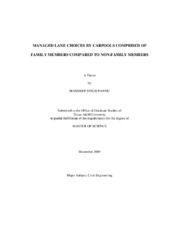| dc.description.abstract | Carpools can be comprised of family members (fampools), non-family members (non-fampools) or a combination of both. Overall, carpool mode share has decreased during the 1980's and 1990's, even as the policies were in place to encourage carpooling, but at the same time the share of fampools increased quite significantly. By analyzing the characteristics of fampools and non-fampools, we can better understand how policies may impact each group. One area of particular interest is the impact of managed lanes on the mode choice of fampools and non-fampools.
For this research, survey data collected from both Houston and Dallas, Texas was used to investigate the mode choice of fampools and non-fampools on managed lanes. The survey data was weighted to better represent the traveler population. The weighted survey data was analyzed to better understand the characteristics of fampools and non-fampools. Non-fampools were formed more frequently in a week than fampools. The average carpool formation time was similar for both fampools and non-fampools at 6.4 minutes and 6.2 minutes, respectively. Fampools rated "drop off kids at school or day care" higher than non-fampools and non-fampools rated "sharing vehicle expenses" higher than fampools as the most important reason for the formation of their current carpool. A majority of travelers from both groups showed an interest in using managed lanes and "travel time reliability" was rated most important factor for this interest. Fampools and non-fampools were split into subgroups based on their current number of passengers. Among these four sub-groups, the majority of respondents were interested in using managed lanes.
Random parameter logit models were developed for both fampools and non-fampools. For the fampools, the value of travel time savings was estimated to be $ 22.80 per hour. Non-fampools were not sensitive to the travel time. Different travel scenarios were simulated for both fampools and non-fampools. The results showed that with increased tolls on the managed lanes the decrease in carpool mode share on managed lanes was compensated by an increase in carpool mode share on the GPLs for both fampools and non-fampools. With an increased toll, both fampools and non-fampools showed less sensitivity to the toll cost. The estimated demand elasticity was fairly inelastic for both fampools and non-fampools. | en |


